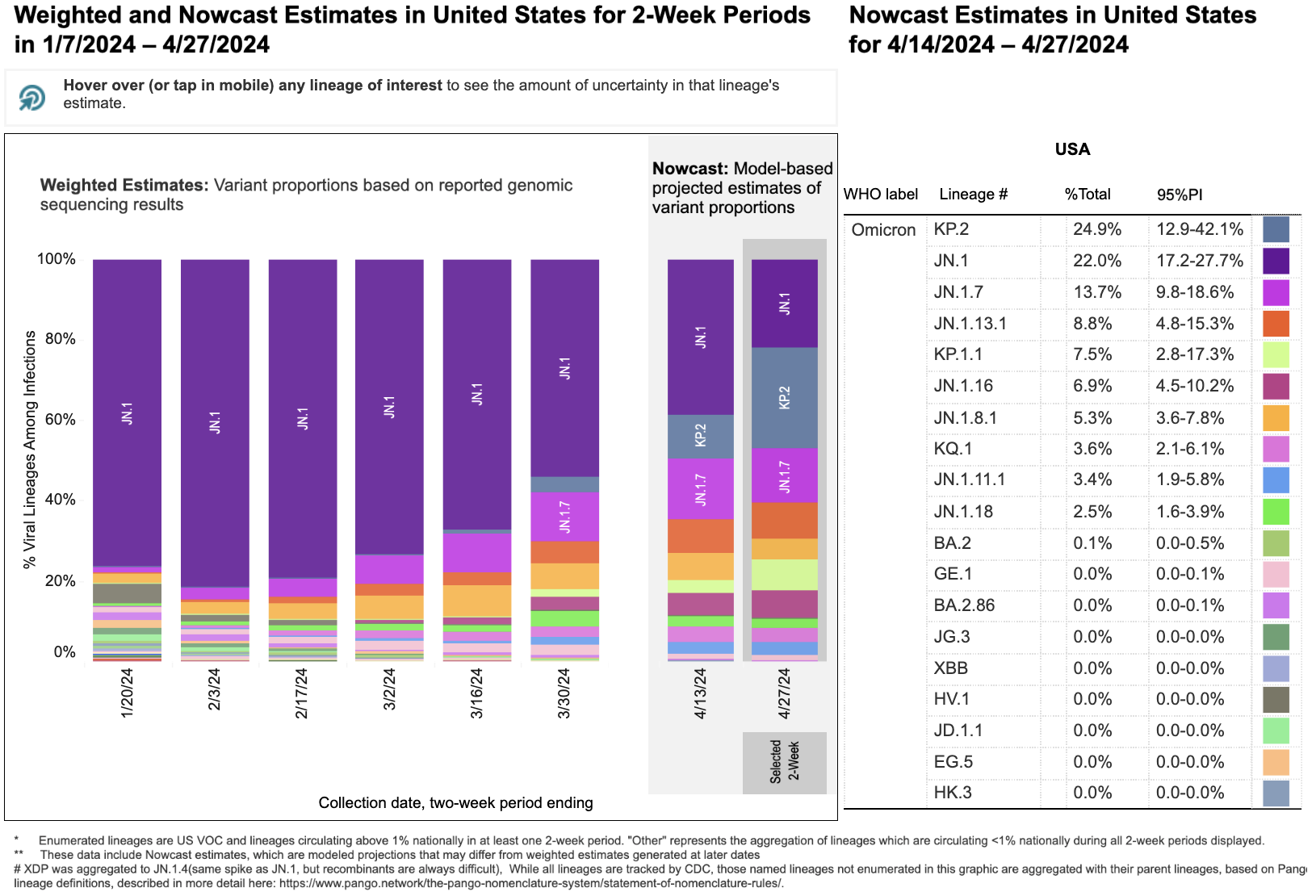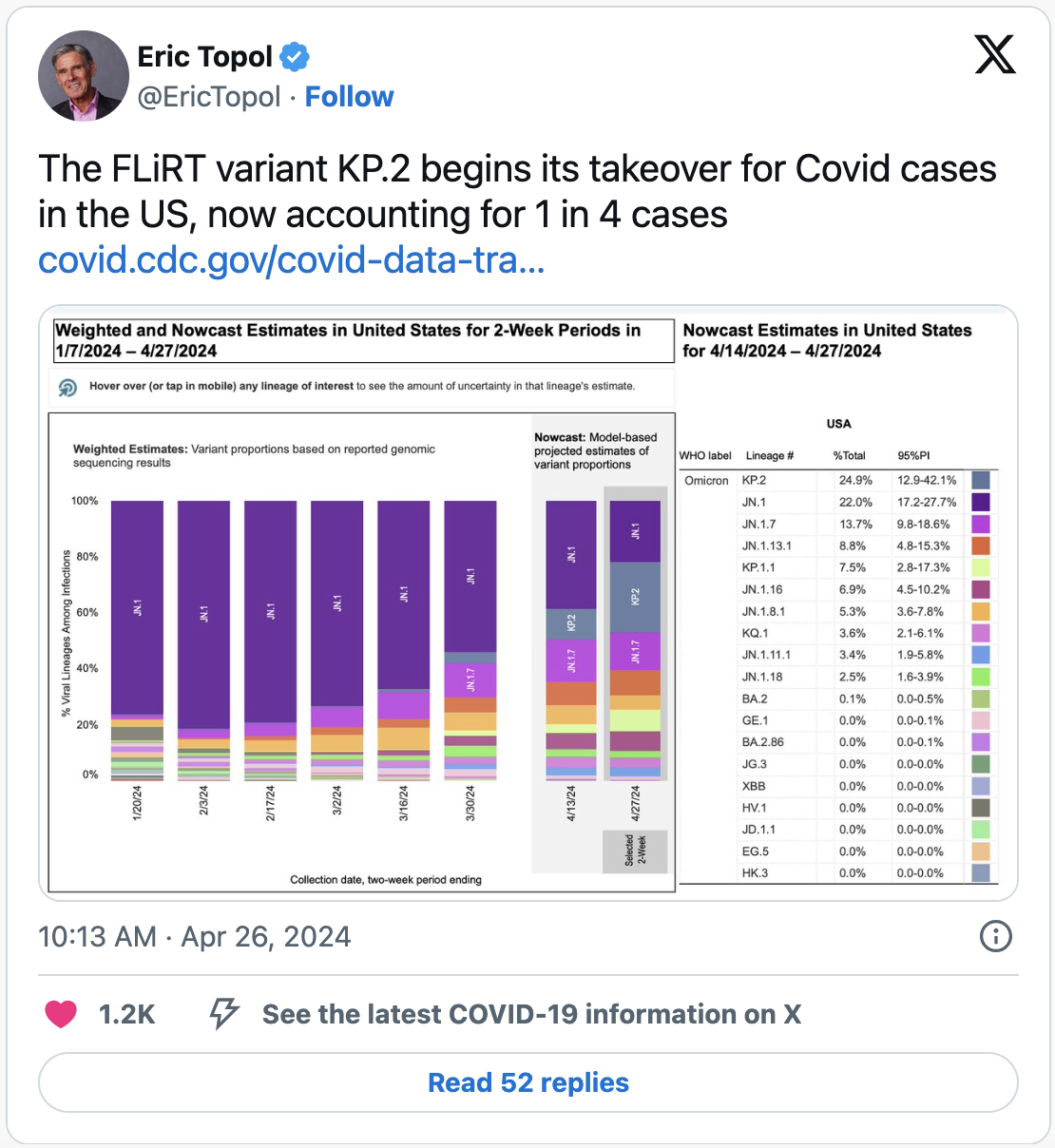
Introduction: Understanding the New ‘FLiRT’ Variants
Over the past few weeks, scientists have noticed a new set of COVID-19 variants nicknamed ‘FLiRT,’ which were found during tests of wastewater. They’re spreading faster than other strains, leading experts to worry that a new wave of COVID-19 might happen this summer. Recently, infections had dropped after a spike last December, but now they’re expected to rise again.
Jay Weiland, a data scientist who’s been very good at predicting past COVID-19 surges, says this new wave could be coming soon. Megan L. Ranney, a doctor and the dean at Yale’s School of Public Health, trusts Weiland’s predictions because he’s usually accurate.
Understanding these new variants is essential. They might bring different symptoms, affect vaccines, and create new challenges for hospitals. As we watch these changes, it’s important to know how the ‘FLiRT’ variants differ from other COVID strains and how we can protect ourselves. Stay tuned for the latest updates so you can stay informed and ready.
A Look at the Summer Surge Warning
Experts believe the new ‘FLiRT’ COVID variants could cause a rise in cases this summer. Changes in their spike protein make them better at infecting people, allowing them to stick around in the body and make folks sick. Dr. Thomas Russo, an infectious disease expert at the University of Buffalo, says many people don’t have strong immunity right now, which makes them more likely to catch COVID-19.
Research from Harvard also shows that the latest COVID booster may not work well against JN.1, a variant that’s part of the ‘FLiRT’ group. This strain spread around the world last winter and now makes up almost all COVID cases in the U.S. Even if it wasn’t common in November, by January it became the top variant. Other variants can also spread quickly if people aren’t protected.
COVID waves have been somewhat predictable. There’s usually a big spike in the winter and a smaller one in the summer. People tend to stay inside with the air conditioning during the hot summer months, where germs spread more easily.
Because of this, Dr. Russo predicts there will likely be another wave of infections and more hospitalizations this summer. Being aware of this warning can help everyone stay safe and healthy.
Symptoms and Severity: How ‘FLiRT’ Differs from Other Variants
The ‘FLiRT’ COVID variants have some differences compared to other strains. These changes, especially in the spike protein, help them attach to cells more easily, which makes them better at infecting people and causing illness. Because of this, they might cause more severe symptoms and make people feel sicker.
The most common symptoms include a fever, sore throat, cough, and tiredness. However, some people also get headaches, muscle pain, and a runny nose. In some cases, FLiRT variants might even lead to severe breathing problems or pneumonia. Their ability to dodge vaccines is worrying too.
Early research shows that the latest booster shot doesn’t work well against JN.1, the dominant ‘FLiRT’ variant. It’s crucial to understand how quickly this variant can spread.
Even though the severity can vary, health experts stress the importance of being on alert for these symptoms and getting tested if you start to feel sick. It’s important to recognize these new signs early, so people can receive treatment quickly if needed and avoid spreading the virus further. Knowing how ‘FLiRT’ differs from other COVID variants can help you protect yourself and others during this new wave.
Vaccines and Treatments: Staying Ahead of the Surge
Even though there’s some concern about how well the newest COVID-19 booster works against the ‘FLiRT’ variants, vaccines are still the best way to protect yourself. If you haven’t gotten the latest booster yet, it’s important to do so as soon as possible. The CDC recommends people over 65 or with weak immune systems should get an additional booster shot four months after their last one.
Dr. Megan Ranney and other experts believe that as the virus keeps changing and immunity weakens over time, people will probably need a yearly booster for the best protection. Dr. Thomas Russo adds that a lot of people have less protection now, which makes it easier for a new wave of COVID to spread.
If you’re sick, staying home until your symptoms get better is crucial. The CDC advises staying isolated for at least 24 hours after your fever is gone. Masks are still helpful, especially if you’re in crowded or poorly ventilated places.
For those with weak immune systems, a new treatment called Pemgarda might help. It’s an antibody medicine given through an IV before someone is exposed to COVID-19, and it can help people who might not build up enough immunity from a vaccine alone. Dr. Shirin Mazumder says it’s another tool that can help folks stay protected along with vaccines and other safety measures. By using vaccines and treatments together, we can stay ahead of the summer COVID surge.
Global Response and Ongoing Research
Around the world, scientists and doctors are keeping a close eye on the ‘FLiRT’ variants. They’re working hard to find out how these new strains spread and how to stop them. Vaccines are still the main tool for fighting COVID-19, and a study published in The Lancet Respiratory Medicine in March 2024 shows that vaccines can help protect people from long COVID too.
Dr. Grace McComsey, who is in charge of the long COVID RECOVER study in Cleveland, is most worried about long COVID. Research from The Lancet Infectious Diseases shows that many who end up with long COVID didn’t even get very sick when they first caught the virus. But later, they struggled with ongoing problems like feeling tired all the time or having a foggy brain.
In a CDC survey, 6.8% of Americans reported symptoms of long COVID, which is an increase from 5.3% last year. Dr. McComsey says that the number of people with long COVID is growing, and it can make people feel sick for a long time, even if their initial infection wasn’t serious.
Scientists don’t know exactly how the new ‘FLiRT’ variants will affect people, but they’re good at spreading and avoiding immunity. Dr. McComsey warns that even if these variants don’t cause the next big wave, a different one will. She says that we need to respect this virus and be careful because it’s still making a lot of people very ill.
Researchers around the world are working hard to understand the virus better and develop new ways to protect people. Ongoing studies, treatments, and vaccines remain our best defense against COVID-19 and its long-term effects.
Conclusion: Preparing for the Summer COVID Surge
The ‘FLiRT’ variants could cause a rise in COVID-19 cases this summer, so it’s important to be prepared. These new variants can spread quickly and sometimes make people sicker. Vaccines and treatments are still the best ways to stay protected, so keeping up with the latest boosters and knowing your options for treatment can make a big difference.
Remember to watch for symptoms like a sore throat, fever, and tiredness, and stay home if you’re sick. It’s important to be careful, especially if you’re around people with weaker immune systems. Scientists are learning more about ‘FLiRT’ every day, and new research will help us find better ways to handle the virus. By staying aware, following health guidelines, and using the tools we have, we can help keep ourselves and others safe this summer.
Get Your Free COVID Tests
To make sure you can stay on top of your health, you can order free COVID-19 tests from Fast Lab Technologies. It’s a quick, simple, and reliable way to check if you’re safe or need to take extra precautions. Protect yourself and those around you this summer—get your $0-cost COVID tests today!






